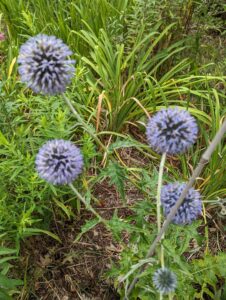 Scent is important to me. I have been known to stop in my tracts to insert my nose into a particularly alluring rose or inhale the intoxicating fragrance of a blooming linden tree. I didn’t expect much when I got up close and personal with an echinops or globe thistle, but to my surprise, the round flowerhead had a pronounced sweet fragrance.
Scent is important to me. I have been known to stop in my tracts to insert my nose into a particularly alluring rose or inhale the intoxicating fragrance of a blooming linden tree. I didn’t expect much when I got up close and personal with an echinops or globe thistle, but to my surprise, the round flowerhead had a pronounced sweet fragrance.
I have added that to the reasons why I admire members of the echinops clan. As is often the case in horticulture, the name is misleading. The flowers are definitely globe-shaped, but echinops is not a thistle at all, but part of the vast Compositae or daisy plant family. To add to the confusion, globe thistles bear ferocious-looking gray-green foliage on lanky stalks. Those leaves look like the result of an aggressive dandelion/thistle mash-up, but their forbidding appearance really only marks them as tools in the arsenal of deception that Mother Nature uses to make gardeners’ lives interesting. A closer look reveals that the prickles are not particularly lethal, and the undersides are soft, touchable, and light-colored.
The “globes” that give globe thistle its name are actually balls of individual tubular flowers clustered into tight, round shapes. The ones in my garden are ping pong ball-size, but the flowerheads may be smaller or larger depending on variety. While there are white globe thistles, the blue-flowered varieties are most common and range in tone from powder blue to a rich, dark shade.
When you add globe thistles’ virtues together, you come up with tough, perennial performers that make great garden exclamation points. Depending on the size of your beds or borders and the variety you choose, they generally work best at the middle to back of the border.
Like their common thistle namesakes, echinops are summer plants, shining from July through September. The flowerheads dry intact on the stalks and make excellent everlasting specimens for indoor arrangements. If you want to speed the drying process and preserve color, pick the stems while the flowers are blooming and hang them upside down in a cool, airy place until they are thoroughly dried.
I am planning on drying some of mine, and I hope that the sweet fragrance lingers–at least a little bit.
Several echinops species dominate the retail market, including Echinops ritro, the small globe thistle. “Small” refers to the relative width of the flowerheads, not the plant’s size. One of the best ritro varieties is the time-tested ‘Veitch’s Blue’, with blue-purple flowers on plants that grow up to four feet tall and two feet wide. Echinops bannaticus, the blue globe thistle; is another tall plant, native to Romania. ‘Blue Glow’ is a bannaticus variety, featuring steely blue flowerheads. ‘Taplow Blue’, also a bannaticus, boasts steel-blue globes on four to five foot stems. Some merchandisers offer Echinops sphaerocephalus, known as the great globe thistle. Pair any of the blue echinops with the white-flowered sphaerocephalus ‘Arctic Glow’, which is a little shorter, but provides great color contrast. Shorter still is the equally white-flowered ‘Star Frost’.
Globe thistles prefer sunlight, but will perform in light shade and actually do best in lean soil. While the plants don’t like desert conditions, they do not need the constant moisture and fertilizer fixes demanded by other summer bloomers like annuals and roses.
“Echinops” is from the Latin word meaning “hedgehog”. Most likely the great plant taxonomist Linnaeus thought the flowerheads looked a little like blue versions of the small animals.
In my part of the world, echinops are in bloom now, with more flowers appearing as the summer progresses. Local garden centers may have some plants on the pallets. If not, order from Digging Dog Nursery, 31101 Middle Ridge Road, Albion, CA 95410, (707) 937-1130; www.diggingdog.com. Print catalog available.
